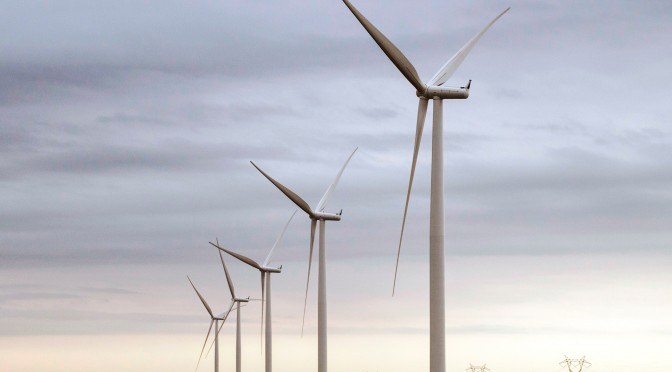Plans to build Arkansas’ first wind farm have sparked interest and excitement in town and across the state, though some wind power experts cautioned against overselling the project.
Representatives of Dragonfly Industries International, a Texas wind energy company, told city officials last month they hope to build dozens of turbines on more than 300 acres of rural land about a mile west of Elm Springs at a cost of at least $100 million, according to City Council and Planning Commission minutes. Power could flow to tens of thousands of homes with the farm’s expected capacity of 80 megawatts.
Company leaders hope Elm Springs would annex the land if the project goes forward, bringing a tax boon to this town of fewer than 2,000 people, according to the minutes.
“This being what it is kind of put us on the map, so to speak,” Mayor Harold Douthit told the Northwest Arkansas Democrat-Gazette (http://bit.ly/1Ky1VAc ). “It could be a very positive effect and influence on our little town here.”
Firm details are hard to come by for now. The company hasn’t met with city officials since mid-December, and Cody Fell, a company spokesman, said Dragonfly’s CEO and others were unavailable to comment. The company launched in Frisco, Texas, but plans to move to Northwest Arkansas in anticipation of the project, according to the City Council minutes.
“I do think that first presentation was well received by the council,” Alderman Kevin Thornton said. “Everyone seemed to look forward to hearing more about the project. I think we’re just in kind of a holding pattern.”
Dragonfly plans to buy the land from Chambers Bank in Danville. It’s valued at about $36,000, according to the Washington County Assessor’s Office, though its asking price could be in the millions. Calls to the bank requesting comment weren’t returned.
Dragonfly’s attempt would be the third since 2008 to bring a wind energy project into the state’s northwest corner.
Kansas-based TradeWind Energy tried in 2008 to build 150 turbines in Searcy County, three counties east of Washington County, according to the Harrison Daily Times. The same year the company also considered a wind farm in Benton County. Both projects fell through — Benton County’s because of concerns over the environmental impact of construction, Searcy County’s because not enough customers showed interest.
Bringing wind energy to Arkansas is a “risky” business, Frank Kelly, board chairman for the Arkansas Renewable Energy Association, said last week.
“I wouldn’t advise anyone doing it,” he said, adding solar power seemed like a better investment, unless a company wants to build turbines reaching the steadiest winds 450 feet up. Dragonfly’s turbines would be 100 feet tall, according to the City Council minutes.
The country’s best wind energy potential is in the Great Plains, between north Texas and North Dakota, according to the U.S. Department of Energy. Wind there reaches an annual average of up to 18 mph at 240 feet up. Arkansas’ windiest region is the northwest, with an average wind speed about 14 mph.
Despite the risk, Kelly said he’d be happy if wind power stuck this time around. Glen Hooks, director of the Sierra Club of Arkansas, was even more enthusiastic.
“Other than our hydropower plants, it’d be the first renewable energy of any kind,” Hooks said, calling the plan “exciting.” The U.S. Environmental Protection Agency is encouraging states to move away from coal power, which could edge out some coal plants and leave room for jobs and economic development on the renewable side, he said.
“This is the perfect example,” Hooks said of the Dragonfly plan. He pointed to LM Wind Power, a Danish company that’s one of the largest turbine-blade suppliers in the world and has a Little Rock factory and sales office.
Arkansas’ wind potential also is higher than earlier estimates showed thanks to better turbines, Hooks said. A 2014 report from the Energy Department and the Southeastern Wind Coalition found Arkansas could supply all of its energy use from wind alone with today’s technology.
American wind power has grown continuously in the past decade, providing more than 4 percent of the nation’s generated electricity in 2014, according to the U.S. Energy Information Administration. More than 15 million homes are powered by wind, the highest level ever and almost double the nation’s wind capacity in 2009.
For now, Arkansas buys its wind energy from Kansas, Oklahoma and other states. Dragonfly’s proposal comes as Clean Line Energy Partners is waiting for federal permission to build a 3,500-megawatt line from the Oklahoma panhandle to Tennessee and provide even more wind power to Arkansas and the rest of the South. The line would enter Arkansas in Crawford County, just south of Washington County.
Mock-ups on Dragonfly’s website show the company intends to use turbines that look something like jet engines, known in the industry as shrouded or ducted turbines. A cylindrical shell would extend forward and backward from the rotor. Units would be mounted in pairs on either side of each tower and could be lowered to the ground in high wind, according to the Elm Springs City Council minutes.
“With patents pending, we look forward to the future of wind energy where bigger is not better, ecosystems are not adversely affected and we do not create an obstructing view of the sunset,” the company wrote on its website.
Some research backs up claims of improvement. A 2013 study by Stanford University researchers found shrouded rotors could double the energy output of a conventional turbine, for example.
The shrouded design nonetheless has prompted skepticism from the industry. Critics say designers rely on pure math and controlled wind tunnels instead of real-world testing or exaggerate results to grab investors’ attention.

